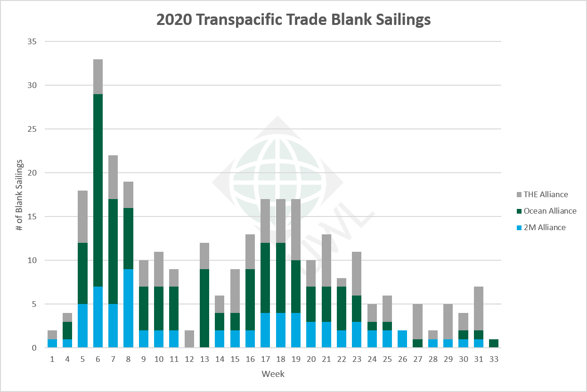3 Things to Know About the Current Ocean Freight Market
- By:
- Kellie Lynch
- Date:
- Jun 17, 2020 2:31:16 PM
- Categories:
- Ocean Freight, Supply Chain, Imports, Exports, Freight Forwarding, Resources, Market Updates, North America, Asia, Shipping & Logistics News, Port Congestion
3 Things You Should Know About the Ocean Freight Market in Q3 2020
The COVID-19 pandemic has created a cloud of uncertainty over 2020 that can make planning for anything difficult. How do you even begin planning your company's shipping activities when the future is unclear? What ocean freight market trends should you be aware of that will impact pricing and available capacity? And how soon do you need to place a booking to ensure your cargo makes it on the boat?
In this article, we'll take a look at 3 things currently happening in the ocean freight market and what to expect this quarter.
At-A-Glance
- Expect more blank sailings throughout Q3 [with downloadable list]
- Capacity remains tight on most lanes & rates are up
- Ships are moving full, so book at least 2-3+ weeks in advance to secure space
1. Expect more blank sailings throughout Q3
Ocean carriers are continuing the trend of blank sailings into Q3. The carriers have forecasted that overall cargo volumes will remain low for much of 2020 due to the COVID-19 pandemic.
In a recent article in the AJOT, CEO and executive director of the Virginia Port Authority, John F. Reinhart, said that the sailing cancellations will continue at least into September.
“It is a significant loss in volume that is being felt throughout the organization and the situation is similar across the entire maritime industry. We are forecasting that this trend will continue through the end of summer because our customers are telling us that the blank sailings will continue into early September. The blank sailings were supposed to subside in early August, but the ocean carriers are telling us the volume just isn’t there yet. Our economy is reawakening and we are optimistic about the future, but the recovery is going to take time and patience,” said Reinhart.
Q3 schedules are still coming out, but here is what we've confirmed so far. We've seen at least 32 cancellations announced through Weeks 25 to 31. 18 previously cancelled sailings have been reinstated since Week 25. We'll continue to update the charts below as more information comes in.

| Total | 2M Alliance | Ocean Alliance | THE Alliance | |
| Q1 | 148 | 36 | 76 | 36 |
| Q2 | 133 | 33 | 50 | 50 |
| Q3 | 19 | 4 | 3 | 12 |
| Total | 300 | 73 | 127 | 103 |
Note: Report only covers cancelled transpacific sailings from East Asia to all USA and Canada destinations. Updated June 18, 2020.
For a complete list of announced blank sailings, download this report.
(Excel .XLSX 1,33 KB) | Updated on June 18, 2020
2. Capacity remains tight on most lanes & rates are up
Even though some voyages have been reinstated, overall cargo volumes remain low. In response, carriers have tightened capacity to keep their operating costs low and prevent rates from falling.
However, as carriers work to optimize their networks and accommodate new demand flows in the current climate, schedule changes have created a ripple effect of their own - causing overbooked vessels, cargo rollovers, and rising rates.
Space from China to USWC is full
On some routes, carriers took too much capacity out, causing a backlog of rolled cargo for shippers in June. This is especially problematic for Asian cargo bound to LAX, where all carriers are reportedly full with a big roll over pool.
"Still many PPE products are in urgent need and [those shippers] pay premium to the carriers to protect the space and loading," our agent in China explained. This makes it very difficult to protect normal cargo on board without rolling. "The rolling is out of control, almost 100% rolling for all shipments," they said.
To deal with the piling containers, carriers have deployed "extra loaders" on some lanes. Extra loaders are additional vessels added to the schedule to temporarily boost capacity.
Space from China to USEC is filling up as well
Space to USEC is also getting very tight and weight limits for sailings transiting the Panama Canal may pose challenges for shippers moving heavier cargoes. This could especially affect cargo out of Northern China (ex NPRC) as many numerous heavy cargoes originate there, which impact whole vessel overweight.
Capacity trends across China:
- In Central China, space to USWC is full, and even though carriers added extra loaders to PSW, the space is still subject to roll. Space to USEC is very tight and carrier ONE currently has a cargo weight limitation.
- In Northern China, space to USWC is full and to the USEC/GULF is tight. Some vessel strings have been restored between PSW and Qingdao so there is space available there, however space to PNW is still tight.
- In Southern China, space from Hong Kong (HKG) to USWC is full and USEC is tight. Shenzen (SZ) space to both USWC & USEC are both full until the end of June.
- From Fujian, space to USWC and USEC are both full. From Xiamen, Space is extremely tight especially for USWC. All carriers have been overbooked until the third week of June for USWC, USEC, and PNW.
- From Taiwan, space is full, especially for PSW.
North America to Asia Pacific
Space and equipment remain tight due to blank sailings. Shippers are advised to book at least 2 to 3 weeks in advance.
Latin American Exports
Blank sailings continue to impact freight out of Brazil and Latin America. Capacity remains tight, especially in the WCSA area, and equipment there remains a challenge. In some areas, ports are congested due to COVID-19 restrictions. Delays at transshipment ports are impacting Brazil shipments to and from Europe.
Contact our Brazil team at uwlbra@shipUWL.com if you need any assistance.
3. Ships are moving full, so book at least 2-3+ weeks in advance to secure space
With capacity so tight, many ships are fully booked and in some cases, overbooked in June. Challenges securing space have even caused some shippers to make multiple bookings for the same container with multiple carriers in an attempt to ensure their cargo moves.
In this climate, it is imperative that you book at least 2 to 3 weeks in advance to get space on a vessel, and even then, your cargo could still be subject to roll.
With sailings so full, shippers have also developed contingency plans to keep their products moving. Alternatives include air freighting some cargo, transporting shipments by long-haul truck to the West Coast rather than rail, or shipping containers to the East Coast for Asian routings instead of the West Coast.
Our team is prepared to provide creative solutions to even your toughest logistical challenges. We have reliable trucking capacity and land transportation services, as well as air freight services available should your shipment need to switch modes. Let us know how we can help here.
So what is a shipper to do?
We expect carriers to continue blanking sailings to maintain rate levels — A tactic which has proven successful for them over the past few months.
Our biggest piece of advice right now is to do what you can to forecast and plan ahead. Don't wait until the last minute. Book at least 2-3 weeks in advance whenever possible to secure space.
Our team is working diligently to keep cargo flowing, if you have any questions or concerns about any of your shipments, contact your LC or reach us here.
Additional Resources
To dig a little deeper into this subject, see these other resources below:



